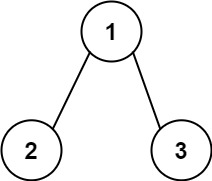Path Sum
Problem Description
Given the root of a binary tree and an integer targetSum, return true if the tree has a root-to-leaf path such that adding up all the values along the path equals targetSum.
Examples
Example 1:

Input: root = [3,9,20,null,null,15,7]
Output: [[3],[20,9],[15,7]]
Example 2:

Input: root = [1,2,3] targetSum = 5
Output: false
Constraints
-
The number of nodes in the tree is in the range .
-
Solution for Binary Tree Problem
Intuition And Approach
To solve this problem, we can use a depth-first search (DFS) to traverse the tree from the root to the leaves, while keeping track of the sum of the values along the current path.
- DFS Traversal: Traverse the tree from the root to the leaves.
- Sum Tracking: Keep track of the sum of the values along the current path.
- Leaf Check: When a leaf node is reached, check if the path sum equals
targetSum.
- Recursive
Code in Different Languages
- Java
- Python
- C++
class Solution {
public boolean hasPathSum(TreeNode root, int targetSum) {
if (root == null) return false;
if (root.left == null && root.right == null) return targetSum == root.val;
return hasPathSum(root.left, targetSum - root.val) || hasPathSum(root.right, targetSum - root.val);
}
}
class Solution:
def hasPathSum(self, root, targetSum):
if not root:
return False
if not root.left and not root.right:
return targetSum == root.val
return self.hasPathSum(root.left, targetSum - root.val) or self.hasPathSum(root.right, targetSum - root.val)
targetSum = 3
Output: true
### Constraints
- The number of nodes in the tree is in the range $[0, 5000]$.
- $-1000 \leq \text{Node.val} \leq 1000$.
- $-1000 \leq \text{targetSum} \leq 1000$.
### Approach
To solve this problem, we can use a depth-first search (DFS) to traverse the tree from the root to the leaves, while keeping track of the sum of the values along the current path.
1. **DFS Traversal:** Traverse the tree from the root to the leaves.
2. **Sum Tracking:** Keep track of the sum of the values along the current path.
3. **Leaf Check:** When a leaf node is reached, check if the path sum equals `targetSum`.
### Solution Codes
#### Codes in Different Languages
<Tabs>
<TabItem value="C++" label="C++" default>
<SolutionAuthor name="@ayushchaware08"/>
```cpp
class Solution {
public:
bool hasPathSum(TreeNode* root, int targetSum) {
if (root == nullptr) return false;
if (root->left == nullptr && root->right == nullptr) return targetSum == root->val;
return hasPathSum(root->left, targetSum - root->val) || hasPathSum(root->right, targetSum - root->val);
}
};
Complexity Analysis
- Time Complexity: where n is the number of nodes in the binary tree.
- Space Complexity: where h is the height of the tree.